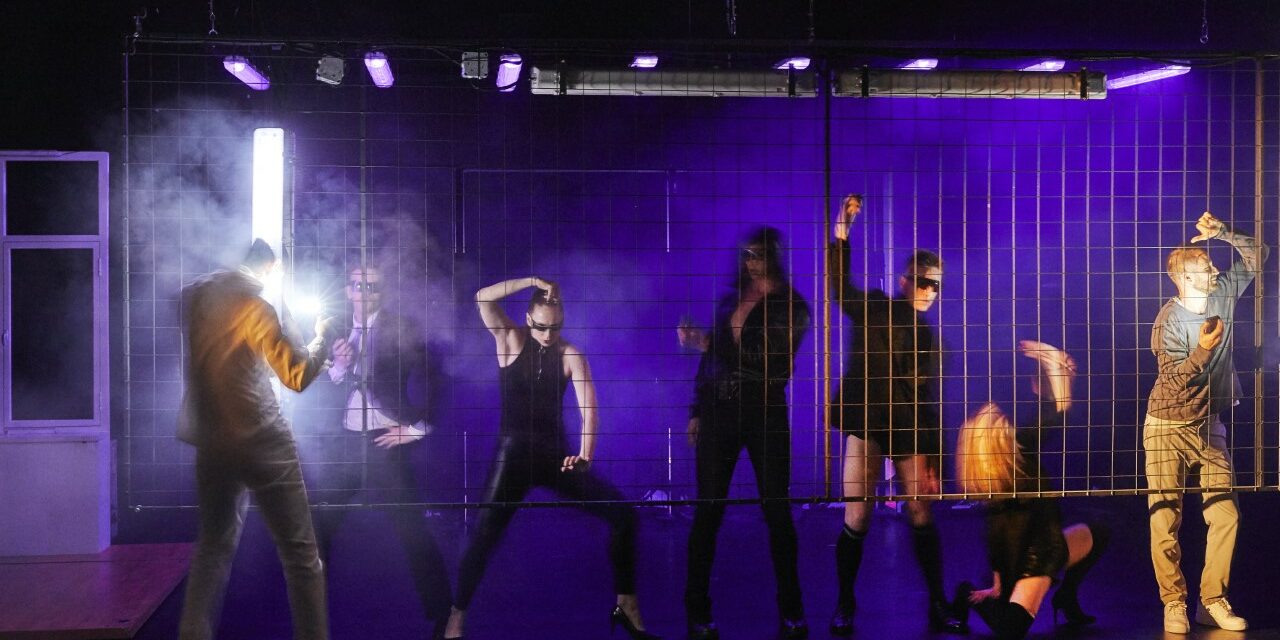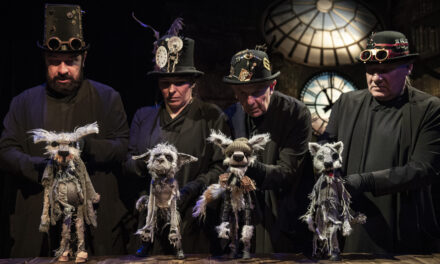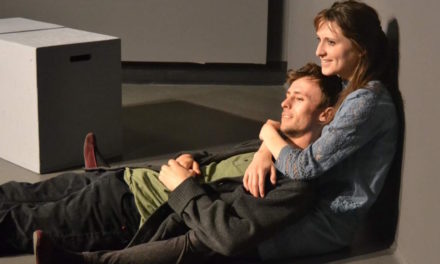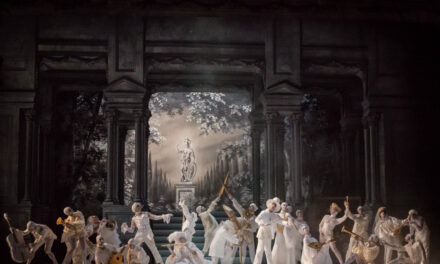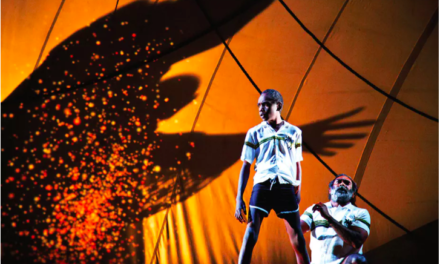Provocation – artistic, political, personal – is the signature style of the Russian theatre director Kirill Serebrennikov, the creator of the performance Outside that had its world premiere at Avignon 2019. It is Serebrennikov’s third production to be featured at the festival, and it is as provocative and personally urgent to the artist as his previous works were. Made without any financial support from the Russian government, as the director’s assistant Anna Shalashova said at the press conference with the Avignon public on July 17, Outside was created with as much artistic and inner freedom as it was possible given Serebrinnikov’s current situation.
Recently brought to the partisan spotlight thanks to the accusations of embezzlement of funds and the ongoing trial connected to these charges, as well as his house arrest that lasted for almost two years (between August 2017 and April 2019), Serebrennikov has become a flamboyant and politically inconvenient persona non grata of the Russian theatre scene. Artistic director of the Gogol Centre in Moscow, which had initially been cherry-picked by the Russian government as a place for experiment, Serebrennikov has been openly criticizing Putin’s regime for its hypocrisy and covert censorship for more than a decade. The famous scandal with his ballet Nuriyev choreographed for the Bolshoi Theatre, which was first canceled because of its alleged propaganda of homosexuality and only opened when the director was under arrest, adds to the colorful but troubled biography of this artist. So, all these controversial topics and facts find an interesting echo in the performative storytelling of Outside.
Written during Serevrennikov’s house arrest, Outside is an homage to the Chinese poet and photographer, Ren Hang, who committed suicide at the age of 30. It is also as testimonial as it is metaphoric to Serebrennikov’s own story. Narrated by a theatre director, who I will refer to as the Artist, who is also under home arrest and is meant to represent Serebrennikov himself, OUTSIDE speaks of the conflict between the Artist and the state, be it today’s China or Russia, the state that puts under surveillance not only peoples’ actual deeds but also their dreams and aspirations. The performance begins with the Artist’s reciting Plato’s parable of the Cave, conversing with his own shadows.
On stage is a rotating rectangular platform with the replica of a large window – it is a room in which the Artist lives and has been confined. But it is also the apartment where Ren Hang consummates his love and death, writes poems and takes photographs. This space outgrows itself as the images from the Artist’s imagination and nightmares come alive; so, the action spills over to the rest of the stage.
Imprisoned in his own home, the Artist reminds us of Vladimir Mayakovsky, the Soviet revolutionary poet of the 1920s allegedly killed by the regime in his own apartment. Real people, mostly the FSB apparatchiks, and the phantoms of his imagination visit him: they are Ren Hang – the Chinese dead poet, Robert Mapplethorpe – the American dead photographer, and the Dancer, who seems to stay in for the Artist’s friend/enemy. The Dancer and his story present an alternative scenario to the aforementioned conflict. The Dancer has chosen to collaborate with the regime – he has grown an enormous bum and elephant-like legs as required by his superiors; and now he is safe, dancing leading roles in the Bolshoi’s company. The Artist, Serebrennikov’s alter-ego, does not make this choice although it is clear that suicide and collaboration were among the possibilities he contemplated.
The provocation that Outside carries goes beyond its topics, of course. An open supporter and promoter of the gay culture, Serebrennikov celebrates male and female nudity on stage. Inspired by Hang’s photographs that often border on pornography, Serebrennikov creates numerous images of same-sex love. Some of them are ironic, as in the scene that takes place in Berghain, a world-famous night club in Berlin, making a nod to the work of Robert Mapplethorpe. Others are metaphorical and poetic. Serebrennikov’s actors, who enact these elaborate images, exhibit impressive skills of physical training. They do not shy away from this revealing and sensationalist choreography that often demands elasticity and strength of the modern dance performers, and as their director, they are not afraid to investigate explicit images of same-sex love.
The truly synthetic performer Odin Lund Biron, who plays the Artist, is absolutely brilliant both as narrator, lead singer and at times dancer of this story. A native speaker of English and the graduate of Shkola-Studiya MKHAT, the major acting school in Russia, his slightly accented Russian adds a special flavor to the image of the Artist: as other, as different, and as a stranger. When Biron switches to English or to a song, the emotional power of his stage presence comes through even more.
Music is another important character in this performance – an original score by Serebrennikov’s long-time collaborator Ilya Demutsky echoes a variety of styles from the Russian avant-garde to classical opera, techno, and popular songs. Mixed with the provocative images that occasionally border on the taboo, this aesthetics can be daring and difficult to follow. Although when looked at through the political lenses of oppression and personal depression that both the Russian artist and his Chinese alter-ego experienced, it becomes clear why Serebrennikov privileges such rough imagery. There is nothing forgiving in the world of censorship – be it outside the family walls or inside them – especially when a young man (Ren Hang) cannot tell the truth about himself to his own mother, keeping her dreams alive even after his own death. “I reject the idea that my son died” – says Ren Hang’s mother, played by another international member of Serebrennikov’s company, Yang Ge. “Death does not exist; it has not yet taken its place.”
The Russian Artist shares this sense of inner confinement with Ren Hang. Back in his apartment, the Artist recounts his daily routine as a prisoner. It includes compulsory walks along the riverbanks near his house. On the other side is a public park with people freely taking their own walks, spending time with their families and celebrating birthdays. Do they understand, however, that all that freedom they think they have is an illusion, the Artist asks. Do they see how many police there are, both in uniforms and in civilian clothing? Do they see that they are in a cage too? Or perhaps they are the policemen themselves and only pretend to be ordinary Russian citizens?
The truth of the physical confinement and the inner freedom that the Russian artist and the Chinese poet share seems to be unattainable to these happy citizens jumping around with the balloons and party candles. This truth can be known only to those who have experienced it themselves, who have become internal exiles against their own will. What am I to them – the Artist continues to ask – invisibility, a sheet of glass that you can neither see nor avoid? And when they look at me, what do they see? Just the words – a thief, a homo, an enemy of the state?
The Chinese poet is not able to bear this kind of questioning and doubt: to be free, he must let everything go, and so he steps out of his 14th-floor apartment window. The Russian artist chooses to stay inside… Perhaps it is an example of a similar choice made by that the ballet dancer who grew an enormous behind. Nobody, however, has the right to judge: Outside serves as Serebrinnikov’s testimony to the suffering of those artists whose work and lifestyle do not please the regime. It is likewise an exploration of how far one can go in their need to seek survival as well as to forgive and forget.
The closing image OUTSIDE creates is of the forest and the lake from the Narcissus’ tale: Ren Hang recites the poems of life and death ready to step into the eternity, to fly over his city that he would never leave as a voluntary exile and join the stars. The performers are all center stage: in the darkness, they hold white flickering stars that they wave at the public. Slowly the stars turn into specks of light and fade… The future of Ren Hang is now known – he has met his eternity; Kirill Serebrennikov’s fate, however, is yet to be determined and played out.
OUTSIDE
Direction, scenography, dramaturgy: Kirill Serebrennikov
With Odin Lund Biron, Alexey Bychkov, Yang Ge, Gueorgui Koudrenko, Nikita Kukushkin, Julia Loboda, Daniil Orlov, Andrey Petrouchenkov, Andrey Poliakov, Evgeny Romantsov, Anastassia Radkova, Evgeny Sangadzhiev, Igor Sharoïko
Choreography: Ivan Estegneev, Evgeny Kulagin
Music: Ilya Demutsky
Stage direction: Anna Shalashova
Production Mart. Foundation, in co-production Festival d’Avignon, Gogol Center, in partnership with France Médias Monde, and with the support of Onda Office national de diffusion artistique
L’Autre Scène du Grand Avignon – Vedène, Avignon Festival, July 16-23, 2019.
This article was originally published on the Capital Critics’ Circle. Reposted with permission. Read the original article.
This post was written by the author in their personal capacity.The opinions expressed in this article are the author’s own and do not reflect the view of The Theatre Times, their staff or collaborators.
This post was written by Yana Meerzon.
The views expressed here belong to the author and do not necessarily reflect our views and opinions.

